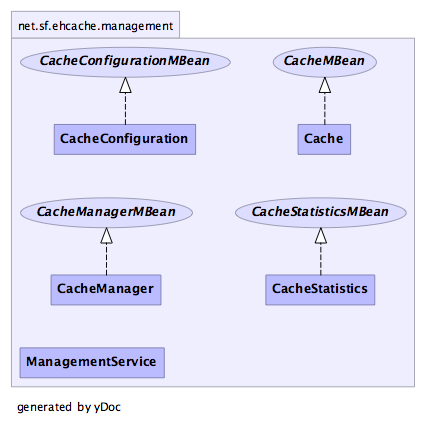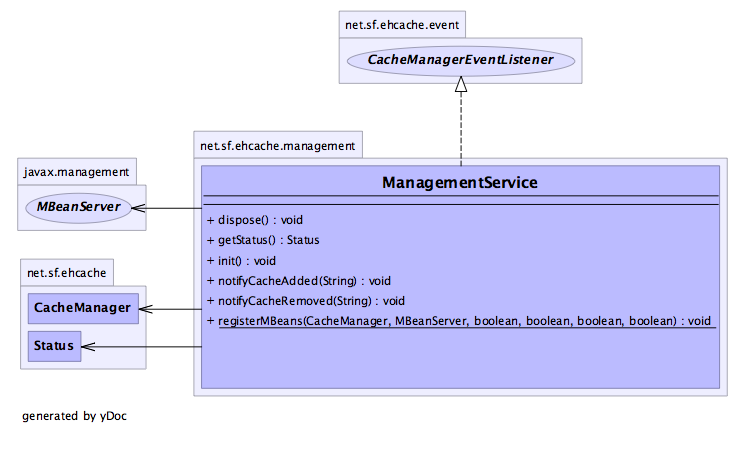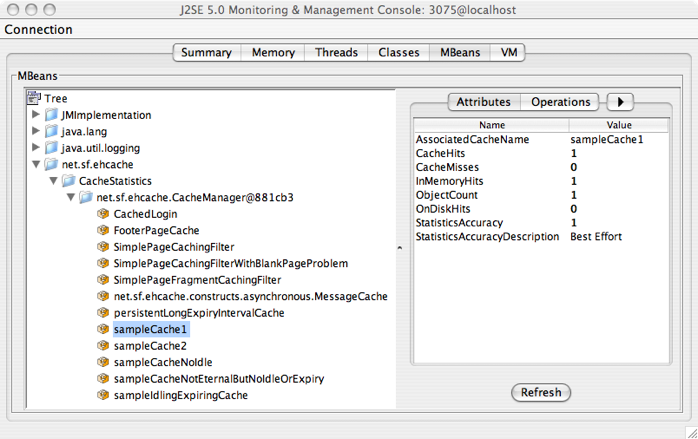- Documentation Overview
- BigMemory Max
- BigMemory Go
- Quartz Scheduler
- Web Sessions
- Universal Messaging
- Cross-Language Clients
- Terracotta Server Array
- TMC Management Console
- WAN Replication
- Previous Versions
- Upgrading from 3.7 or 4.0
- Working with License Files
- Working with Apache Maven
Products
Components
More Documentation
Open Source
Management and Monitoring using JMX
Introduction
JMX creates a standard way of instrumenting classes and making them available to a management and monitoring infrastructure. This provides an alternative to the Terracotta Management Server for custom or third-party tools.
JMX Overview
The net.sf.ehcache.management package contains MBeans and a ManagementService for JMX management of BigMemory Max. It is in a separate package so that JMX libraries are only required if you want to use it - there is no leakage of JMX dependencies
into the core Ehcache package.
Use net.sf.ehcache.management.ManagementService.registerMBeans(...) static method
to register a selection of MBeans to the MBeanServer provided to the method. If you wish to monitor Ehcache but not use JMX, use the existing public methods on Cache and CacheStatistics.
The Management package is illustrated in the follwing image.

MBeans
BigMemory Max supports Standard MBeans. MBeans are available for the following:
- CacheManager
- Cache
- CacheConfiguration
- CacheStatistics
All MBean attributes are available to a local MBeanServer. The CacheManager MBean allows traversal to its collection of Cache MBeans. Each Cache MBean likewise allows traversal to its CacheConfiguration MBean and its CacheStatistics MBean.
JMX Remoting
The Remote API allows connection from a remote JMX Agent to an MBeanServer via an MBeanServerConnection.
Only Serializable attributes are available remotely. The following Ehcache MBean attributes are available remotely:
- limited CacheManager attributes
- limited Cache attributes
- all CacheConfiguration attributes
- all CacheStatistics attributes
Most attributes use built-in types. To access all attributes, add ehcache.jar to the remote JMX client's
classpath. For example, jconsole -J-Djava.class.path=ehcache.jar.
ObjectName naming scheme
- CacheManager - "net.sf.ehcache:type=CacheManager,name=<CacheManager>"
- Cache - "net.sf.ehcache:type=Cache,CacheManager=<cacheManagerName>,name=<cacheName>"
- CacheConfiguration
- "net.sf.ehcache:type=CacheConfiguration,CacheManager=<cacheManagerName>,name=<cacheName>"
- CacheStatistics - "net.sf.ehcache:type=CacheStatistics,CacheManager=<cacheManagerName>,name=<cacheName>"
The Management Service
The ManagementService class is the API entry point.
 There is only one method,
There is only one method, ManagementService.registerMBeans which is used to initiate JMX registration
of a CacheManager's instrumented MBeans.
The ManagementService is a CacheManagerEventListener and
is therefore notified of any new Caches added or disposed and updates the MBeanServer appropriately.
Initiated MBeans remain registered in the MBeanServer until the CacheManager shuts down, at which time
the MBeans are deregistered. This ensures correct behavior in application servers where applications are
deployed and undeployed.
/**
* This method causes the selected monitoring options to be be registered
* with the provided MBeanServer for caches in the given CacheManager.
*
* While registering the CacheManager enables traversal to all of the other
* items,
* this requires programmatic traversal. The other options allow entry points closer
* to an item of interest and are more accessible from JMX management tools like JConsole.
* Moreover CacheManager and Cache are not serializable, so remote monitoring is not
* possible * for CacheManager or Cache, while CacheStatistics and CacheConfiguration are.
* Finally * CacheManager and Cache enable management operations to be performed.
*
* Once monitoring is enabled caches will automatically added and removed from the
* MBeanServer * as they are added and disposed of from the CacheManager. When the
* CacheManager itself * shutsdown all registered MBeans will be unregistered.
*
* @param cacheManager the CacheManager to listen to
* @param mBeanServer the MBeanServer to register MBeans to
* @param registerCacheManager Whether to register the CacheManager MBean
* @param registerCaches Whether to register the Cache MBeans
* @param registerCacheConfigurations Whether to register the CacheConfiguration MBeans
* @param registerCacheStatistics Whether to register the CacheStatistics MBeans
*/
public static void registerMBeans(
net.sf.ehcache.CacheManager cacheManager,
MBeanServer mBeanServer,
boolean registerCacheManager,
boolean registerCaches,
boolean registerCacheConfigurations,
boolean registerCacheStatistics) throws CacheException {
JConsole Example
This example shows how to register CacheStatistics in the JDK platform MBeanServer, which works with the JConsole management agent.
CacheManager manager = new CacheManager();
MBeanServer mBeanServer = ManagementFactory.getPlatformMBeanServer();
ManagementService.registerMBeans(manager, mBeanServer, false, false, false, true);
CacheStatistics MBeans are then registered.
 CacheStatistics MBeans in JConsole
CacheStatistics MBeans in JConsole
Hibernate statistics
If you are running Terracotta clustered caches as hibernate second-level cache provider, it is possible to access
the hibernate statistics and Ehcache stats via JMX.
EhcacheHibernateMBean is the main interface that exposes all the APIs via JMX. It basically extends
two interfaces -- EhcacheStats and HibernateStats. Please look into the specific interface for more
details. You may also refer to this online tutorial.
Performance
Collection of cache statistics is not entirely free of overhead, however, the statistics API switches on/off automatically according to usage. If you need few statistics, you incur little overhead; on the other hand, as you use more statistics, you can incur more. Statistics are off by default.
SSL-Secured JMX Monitoring
Note: For a brief overview of Terracotta security with links to individual topics, see Security Overview.
This page documents setting up an SSL-enabled connection for remote monitoring of a Terracotta Server from a simple Java client using Java Management Extensions (JMX) technology.
Before creating this connection, be sure to complete the instructions on the Securing Terracotta Clusters with SSL page.
Compile the Client
Use the sample client code below, but adapt the host, port, username, and password variables according to your setup.
import java.util.HashMap;
import java.util.Map;
import javax.management.remote.JMXConnector;
import javax.management.remote.JMXConnectorFactory;
import javax.management.remote.JMXServiceURL;
import javax.management.remote.rmi.RMIConnectorServer;
import javax.rmi.ssl.SslRMIClientSocketFactory;
import javax.rmi.ssl.SslRMIServerSocketFactory;
public class Main {
public static void main(String[] args) throws Exception {
String host = "terracotta-server-host";
String port = "9520";
String username = "terracotta";
String password = "terracotta-user-password";
Object[] credentials = { username, password.toCharArray() };
SslRMIClientSocketFactory csf = new SslRMIClientSocketFactory();
SslRMIServerSocketFactory ssf = new SslRMIServerSocketFactory();
Map<String, Object> env = new HashMap<String, Object>();
env.put(RMIConnectorServer.RMI_CLIENT_SOCKET_FACTORY_ATTRIBUTE, csf);
env.put(RMIConnectorServer.RMI_SERVER_SOCKET_FACTORY_ATTRIBUTE, ssf);
env.put("com.sun.jndi.rmi.factory.socket", csf);
env.put("jmx.remote.credentials", credentials);
JMXServiceURL serviceURL = new JMXServiceURL("service:jmx:rmi://" + host + ":" + port +
"/jndi/rmi://" + host + ":" + port + "/jmxrmi");
JMXConnector jmxConnector = JMXConnectorFactory.connect(serviceURL, env);
// do some work with the JMXConnector
jmxConnector.close();
}
}
Run the Client
After compiling your client, configure the JVM with a truststore containing your Terracotta Server's certificate. You can simply re-use the one created for the Terracotta Server (refer to Securing Terracotta Clusters with SSL).
% java -Djavax.net.ssl.trustStore=/your/path/to/truststore.jks \
-Djavax.net.ssl.trustStorePassword=your_truststore_password \
Main
About the Credentials
In the above example, the client's credentials are encoded as an array of Objects. The Object array contains the username as a String in the array's first slot, and the password as a char[] in the array's second slot. The Object array is then passed to the connection as the "jmx.remote.credentials" entry. Passing the credentials in this format is necessary to avoid an authentication failure, except for the following exception. If you are using the JConsole tool, the credentials are sent as String[]{String,String} instead of String[]{String,char[]}.
Troubleshooting
Password stack trace
The stack trace below indicates that the password you specified in the javax.net.ssl.trustStorePassword system property is not the same as in the truststore you specified in the javax.net.ssl.trustStore system property.
Exception in thread "main" java.io.IOException: Failed to retrieve RMIServer stub: javax.naming.CommunicationException [Root exception is java.rmi.ConnectIOException: Exception creating connection to: localhost; nested exception is:
java.net.SocketException: java.security.NoSuchAlgorithmException: Error constructing implementation (algorithm: Default, provider: SunJSSE, class: com.sun.net.ssl.internal.ssl.DefaultSSLContextImpl)]
at javax.management.remote.rmi.RMIConnector.connect(RMIConnector.java:338)
at javax.management.remote.JMXConnectorFactory.connect(JMXConnectorFactory.java:248)
at Main.main(Main.java:31)
at sun.reflect.NativeMethodAccessorImpl.invoke0(Native Method)
at sun.reflect.NativeMethodAccessorImpl.invoke(NativeMethodAccessorImpl.java:39)
at sun.reflect.DelegatingMethodAccessorImpl.invoke(DelegatingMethodAccessorImpl.java:25)
at java.lang.reflect.Method.invoke(Method.java:597)
at com.intellij.rt.execution.application.AppMain.main(AppMain.java:120)
Caused by: javax.naming.CommunicationException [Root exception is java.rmi.ConnectIOException: Exception creating connection to: localhost; nested exception is:
java.net.SocketException: java.security.NoSuchAlgorithmException: Error constructing implementation (algorithm: Default, provider: SunJSSE, class: com.sun.net.ssl.internal.ssl.DefaultSSLContextImpl)]
at com.sun.jndi.rmi.registry.RegistryContext.lookup(RegistryContext.java:101)
at com.sun.jndi.toolkit.url.GenericURLContext.lookup(GenericURLContext.java:185)
at javax.naming.InitialContext.lookup(InitialContext.java:392)
at javax.management.remote.rmi.RMIConnector.findRMIServerJNDI(RMIConnector.java:1886)
at javax.management.remote.rmi.RMIConnector.findRMIServer(RMIConnector.java:1856)
at javax.management.remote.rmi.RMIConnector.connect(RMIConnector.java:255)
... 7 more
Caused by: java.rmi.ConnectIOException: Exception creating connection to: localhost; nested exception is:
java.net.SocketException: java.security.NoSuchAlgorithmException: Error constructing implementation (algorithm: Default, provider: SunJSSE, class: com.sun.net.ssl.internal.ssl.DefaultSSLContextImpl)
at sun.rmi.transport.tcp.TCPEndpoint.newSocket(TCPEndpoint.java:614)
at sun.rmi.transport.tcp.TCPChannel.createConnection(TCPChannel.java:198)
at sun.rmi.transport.tcp.TCPChannel.newConnection(TCPChannel.java:184)
at sun.rmi.server.UnicastRef.newCall(UnicastRef.java:322)
at sun.rmi.registry.RegistryImpl_Stub.lookup(Unknown Source)
at com.sun.jndi.rmi.registry.RegistryContext.lookup(RegistryContext.java:97)
... 12 more
Caused by: java.net.SocketException: java.security.NoSuchAlgorithmException: Error constructing implementation (algorithm: Default, provider: SunJSSE, class: com.sun.net.ssl.internal.ssl.DefaultSSLContextImpl)
at javax.net.ssl.DefaultSSLSocketFactory.throwException(SSLSocketFactory.java:179)
at javax.net.ssl.DefaultSSLSocketFactory.createSocket(SSLSocketFactory.java:192)
at javax.rmi.ssl.SslRMIClientSocketFactory.createSocket(SslRMIClientSocketFactory.java:105)
at sun.rmi.transport.tcp.TCPEndpoint.newSocket(TCPEndpoint.java:595)
... 17 more
Caused by: java.security.NoSuchAlgorithmException: Error constructing implementation (algorithm: Default, provider: SunJSSE, class: com.sun.net.ssl.internal.ssl.DefaultSSLContextImpl)
at java.security.Provider$Service.newInstance(Provider.java:1245)
at sun.security.jca.GetInstance.getInstance(GetInstance.java:220)
at sun.security.jca.GetInstance.getInstance(GetInstance.java:147)
at javax.net.ssl.SSLContext.getInstance(SSLContext.java:125)
at javax.net.ssl.SSLContext.getDefault(SSLContext.java:68)
at javax.net.ssl.SSLSocketFactory.getDefault(SSLSocketFactory.java:102)
at javax.rmi.ssl.SslRMIClientSocketFactory.getDefaultClientSocketFactory(SslRMIClientSocketFactory.java:192)
at javax.rmi.ssl.SslRMIClientSocketFactory.createSocket(SslRMIClientSocketFactory.java:102)
... 18 more
Caused by: java.io.IOException: Keystore was tampered with, or password was incorrect
at sun.security.provider.JavaKeyStore.engineLoad(JavaKeyStore.java:771)
at sun.security.provider.JavaKeyStore$JKS.engineLoad(JavaKeyStore.java:38)
at java.security.KeyStore.load(KeyStore.java:1185)
at com.sun.net.ssl.internal.ssl.TrustManagerFactoryImpl.getCacertsKeyStore(TrustManagerFactoryImpl.java:202)
at com.sun.net.ssl.internal.ssl.DefaultSSLContextImpl.getDefaultTrustManager(DefaultSSLContextImpl.java:70)
at com.sun.net.ssl.internal.ssl.DefaultSSLContextImpl.<init>(DefaultSSLContextImpl.java:40)
at sun.reflect.NativeConstructorAccessorImpl.newInstance0(Native Method)
at sun.reflect.NativeConstructorAccessorImpl.newInstance(NativeConstructorAccessorImpl.java:39)
at sun.reflect.DelegatingConstructorAccessorImpl.newInstance(DelegatingConstructorAccessorImpl.java:27)
at java.lang.reflect.Constructor.newInstance(Constructor.java:513)
at java.lang.Class.newInstance0(Class.java:357)
at java.lang.Class.newInstance(Class.java:310)
at java.security.Provider$Service.newInstance(Provider.java:1221)
... 25 more
Caused by: java.security.UnrecoverableKeyException: Password verification failed
at sun.security.provider.JavaKeyStore.engineLoad(JavaKeyStore.java:769)
... 37 more
Truststore stack trace
The stack trace below indicates that the truststore you specified in the javax.net.ssl.trustStore system property does not exist or cannot be read.
Exception in thread "main" java.io.IOException: Failed to retrieve RMIServer stub: javax.naming.CommunicationException [Root exception is java.rmi.ConnectIOException: error during JRMP connection establishment; nested exception is:
javax.net.ssl.SSLException: java.lang.RuntimeException: Unexpected error: java.security.InvalidAlgorithmParameterException: the trustAnchors parameter must be non-empty]
at javax.management.remote.rmi.RMIConnector.connect(RMIConnector.java:338)
at javax.management.remote.JMXConnectorFactory.connect(JMXConnectorFactory.java:248)
at Main.main(Main.java:31)
at sun.reflect.NativeMethodAccessorImpl.invoke0(Native Method)
at sun.reflect.NativeMethodAccessorImpl.invoke(NativeMethodAccessorImpl.java:39)
at sun.reflect.DelegatingMethodAccessorImpl.invoke(DelegatingMethodAccessorImpl.java:25)
at java.lang.reflect.Method.invoke(Method.java:597)
at com.intellij.rt.execution.application.AppMain.main(AppMain.java:120)
Caused by: javax.naming.CommunicationException [Root exception is java.rmi.ConnectIOException: error during JRMP connection establishment; nested exception is:
javax.net.ssl.SSLException: java.lang.RuntimeException: Unexpected error: java.security.InvalidAlgorithmParameterException: the trustAnchors parameter must be non-empty]
at com.sun.jndi.rmi.registry.RegistryContext.lookup(RegistryContext.java:101)
at com.sun.jndi.toolkit.url.GenericURLContext.lookup(GenericURLContext.java:185)
at javax.naming.InitialContext.lookup(InitialContext.java:392)
at javax.management.remote.rmi.RMIConnector.findRMIServerJNDI(RMIConnector.java:1886)
at javax.management.remote.rmi.RMIConnector.findRMIServer(RMIConnector.java:1856)
at javax.management.remote.rmi.RMIConnector.connect(RMIConnector.java:255)
... 7 more
Caused by: java.rmi.ConnectIOException: error during JRMP connection establishment; nested exception is:
javax.net.ssl.SSLException: java.lang.RuntimeException: Unexpected error: java.security.InvalidAlgorithmParameterException: the trustAnchors parameter must be non-empty
at sun.rmi.transport.tcp.TCPChannel.createConnection(TCPChannel.java:286)
at sun.rmi.transport.tcp.TCPChannel.newConnection(TCPChannel.java:184)
at sun.rmi.server.UnicastRef.newCall(UnicastRef.java:322)
at sun.rmi.registry.RegistryImpl_Stub.lookup(Unknown Source)
at com.sun.jndi.rmi.registry.RegistryContext.lookup(RegistryContext.java:97)
... 12 more
Caused by: javax.net.ssl.SSLException: java.lang.RuntimeException: Unexpected error: java.security.InvalidAlgorithmParameterException: the trustAnchors parameter must be non-empty
at com.sun.net.ssl.internal.ssl.Alerts.getSSLException(Alerts.java:190)
at com.sun.net.ssl.internal.ssl.SSLSocketImpl.fatal(SSLSocketImpl.java:1747)
at com.sun.net.ssl.internal.ssl.SSLSocketImpl.fatal(SSLSocketImpl.java:1708)
at com.sun.net.ssl.internal.ssl.SSLSocketImpl.handleException(SSLSocketImpl.java:1691)
at com.sun.net.ssl.internal.ssl.SSLSocketImpl.handleException(SSLSocketImpl.java:1617)
at com.sun.net.ssl.internal.ssl.AppOutputStream.write(AppOutputStream.java:105)
at java.io.BufferedOutputStream.flushBuffer(BufferedOutputStream.java:65)
at java.io.BufferedOutputStream.flush(BufferedOutputStream.java:123)
at java.io.DataOutputStream.flush(DataOutputStream.java:106)
at sun.rmi.transport.tcp.TCPChannel.createConnection(TCPChannel.java:211)
... 16 more
Caused by: java.lang.RuntimeException: Unexpected error: java.security.InvalidAlgorithmParameterException: the trustAnchors parameter must be non-empty
at sun.security.validator.PKIXValidator.<init>(PKIXValidator.java:57)
at sun.security.validator.Validator.getInstance(Validator.java:161)
at com.sun.net.ssl.internal.ssl.X509TrustManagerImpl.getValidator(X509TrustManagerImpl.java:108)
at com.sun.net.ssl.internal.ssl.X509TrustManagerImpl.checkServerTrusted(X509TrustManagerImpl.java:204)
at com.sun.net.ssl.internal.ssl.X509TrustManagerImpl.checkServerTrusted(X509TrustManagerImpl.java:249)
at com.sun.net.ssl.internal.ssl.ClientHandshaker.serverCertificate(ClientHandshaker.java:1188)
at com.sun.net.ssl.internal.ssl.ClientHandshaker.processMessage(ClientHandshaker.java:135)
at com.sun.net.ssl.internal.ssl.Handshaker.processLoop(Handshaker.java:593)
at com.sun.net.ssl.internal.ssl.Handshaker.process_record(Handshaker.java:529)
at com.sun.net.ssl.internal.ssl.SSLSocketImpl.readRecord(SSLSocketImpl.java:943)
at com.sun.net.ssl.internal.ssl.SSLSocketImpl.performInitialHandshake(SSLSocketImpl.java:1188)
at com.sun.net.ssl.internal.ssl.SSLSocketImpl.writeRecord(SSLSocketImpl.java:654)
at com.sun.net.ssl.internal.ssl.AppOutputStream.write(AppOutputStream.java:100)
... 20 more
Caused by: java.security.InvalidAlgorithmParameterException: the trustAnchors parameter must be non-empty
at java.security.cert.PKIXParameters.setTrustAnchors(PKIXParameters.java:183)
at java.security.cert.PKIXParameters.<init>(PKIXParameters.java:103)
at java.security.cert.PKIXBuilderParameters.<init>(PKIXBuilderParameters.java:87)
at sun.security.validator.PKIXValidator.<init>(PKIXValidator.java:55)
... 32 more
Conditional stack trace
The stack trace below indicates that one of the following conditions is true:
- The username you specified does not exist.
- The password you specified is incorrect.
The credentials field is not an Object array containing the username as a String in the array's first slot and the password as a char[] in the array's second slot.
Exception in thread "main" java.lang.SecurityException: Username and/or password is not valid! at com.tc.management.EnterpriseL2Management$1.authenticate(EnterpriseL2Management.java:202) at javax.management.remote.rmi.RMIServerImpl.doNewClient(RMIServerImpl.java:213) at javax.management.remote.rmi.RMIServerImpl.newClient(RMIServerImpl.java:180) at sun.reflect.NativeMethodAccessorImpl.invoke0(Native Method) at sun.reflect.NativeMethodAccessorImpl.invoke(NativeMethodAccessorImpl.java:39) at sun.reflect.DelegatingMethodAccessorImpl.invoke(DelegatingMethodAccessorImpl.java:25) at java.lang.reflect.Method.invoke(Method.java:597) at sun.rmi.server.UnicastServerRef.dispatch(UnicastServerRef.java:303) at sun.rmi.transport.Transport$1.run(Transport.java:159) at java.security.AccessController.doPrivileged(Native Method) at sun.rmi.transport.Transport.serviceCall(Transport.java:155) at sun.rmi.transport.tcp.TCPTransport.handleMessages(TCPTransport.java:535) at sun.rmi.transport.tcp.TCPTransport$ConnectionHandler.run0(TCPTransport.java:790) at sun.rmi.transport.tcp.TCPTransport$ConnectionHandler.run(TCPTransport.java:649) at java.util.concurrent.ThreadPoolExecutor$Worker.runTask(ThreadPoolExecutor.java:895) at java.util.concurrent.ThreadPoolExecutor$Worker.run(ThreadPoolExecutor.java:918) at java.lang.Thread.run(Thread.java:680) at sun.rmi.transport.StreamRemoteCall.exceptionReceivedFromServer(StreamRemoteCall.java:255) at sun.rmi.transport.StreamRemoteCall.executeCall(StreamRemoteCall.java:233) at sun.rmi.server.UnicastRef.invoke(UnicastRef.java:142) at javax.management.remote.rmi.RMIServerImpl_Stub.newClient(Unknown Source) at javax.management.remote.rmi.RMIConnector.getConnection(RMIConnector.java:2327) at javax.management.remote.rmi.RMIConnector.connect(RMIConnector.java:277) at javax.management.remote.JMXConnectorFactory.connect(JMXConnectorFactory.java:248) at Main.main(Main.java:31) at sun.reflect.NativeMethodAccessorImpl.invoke0(Native Method) at sun.reflect.NativeMethodAccessorImpl.invoke(NativeMethodAccessorImpl.java:39) at sun.reflect.DelegatingMethodAccessorImpl.invoke(DelegatingMethodAccessorImpl.java:25) at java.lang.reflect.Method.invoke(Method.java:597) at com.intellij.rt.execution.application.AppMain.main(AppMain.java:120)